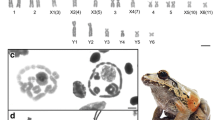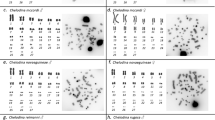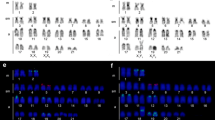Abstract
Sex chromosomes in mammals are generally of the XY type with the X chromosome constituting 5% by weight of the haploid chromosomal complement. Unusually large sex chromosomes have been described in a few species all of which belong to theRodentia, but two members of theArtiodactyla, the African sitatunga and the Indian blackbuck, have now been found to have this peculiarity. The sitatunga has an X chromosome that represents 13.08% and a Y that represents 7.29% of the haploid complement, and the X of the blackbuck represents 14.96% of its haploid complement. Portions of both extra large sex chromosomes in a pair are late replicating. Theories concerning the formation of these outsized chromosomes are discussed.
Similar content being viewed by others
References
Benirschke, K.: The chromosomes of the Canadian porcupine,Erethizon dorsatum. J. Hered. (in press).
Fredga, K., andB. Santesson: Male meiosis in the Syrian, Chinese and European hamsters. Hereditas (Lund)52, 36–48 (1964).
Galton, M., K. Benirschke, andS. Ohno: Sex chromosomes of the chinchilla: allocycly and duplication sequence in somatic cells and behavior in meiosis. Chromosoma (Berl.)16, 668–680 (1965).
Hultén, M., J. Lindsten, P. L. Ming, andM. Fraccaro: The XY bivalent in human male meiosis. Ann. hum. Genet.30, 119–123 (1966).
Koulischer, L.: Acta Zool. Path. Antverpiensia (in press).
Mandel, P., P. Métai etS. Cuny: Les quantités d'acide desoxypentose-nucléique par leucocyte chez diverses espèces de mammifères. C.R. Acad. Sci. (Paris)231, 1172–1174 (1950).
Matthey, R.: L'évolution de la formule chromosomiale chez les vertébrés. Experientia (Basel)1, 50–56 (1945);
—: Cytologie comparée desCricetinae palé-arctiques et americains. Rev. suisse Zool.68, 41–61 (1961).
Nes, N.: The chromosomes ofChinchilla lanigera. Acta vet. scand.4, 128–135 (1963).
Ohno, S.: A phylogenetic view of the X-chromosome in man. Ann. Génét.8, 3–8 (1965).
—:W. Beçak, andM. L. Beçak: X-autosome ratio and the behavior pattern of individual X-chromosomes in placental mammals. Chromosoma (Berl.)15, 14–30 (1964).
—: andC. Weiller: Relationship between large Y-chromosome and side-by-side pairing of the XY-bivalent observed in the Chinese hamster,Cricetulus griseus. Chromosoma (Berl.)13, 106–110 (1962).
Schmid W., D. W. Smith u.K. Theiler: Chromatinmuster in verschiedenen Zelltypen und Lokalisation von Heterochromatin auf Metaphasechromosomen beiMicrotus agrestis, Mesocricetus auratus, Cavia cobaya und beim Menschen. Arch. Klaus-Stift. Vererb.-Forsch.40, 35–49 (1965).
Utakoji, T.: On the homology between the X and the Y chromosomes of the Chinese hamster. Chromosoma (Berl.)18, 449–454 (1966).
Wolf, U., G. Flinspach, R. Böhm u.S. Ohno: DNS-Reduplicationsmuster bei den Riesen-Geschlechtschromosomen vonMicrotus agrestis, Chromosoma (Berl.)16, 609–617 (1965).
Author information
Authors and Affiliations
Rights and permissions
About this article
Cite this article
Wurster, D.H., Benirschke, K. & Noelke, H. Unusually large sex chromosomes in the sitatunga (Tragelaphus spekei) and the blackbuck (Antilope cervicapra). Chromosoma 23, 317–323 (1968). https://doi.org/10.1007/BF02451003
Received:
Issue Date:
DOI: https://doi.org/10.1007/BF02451003




